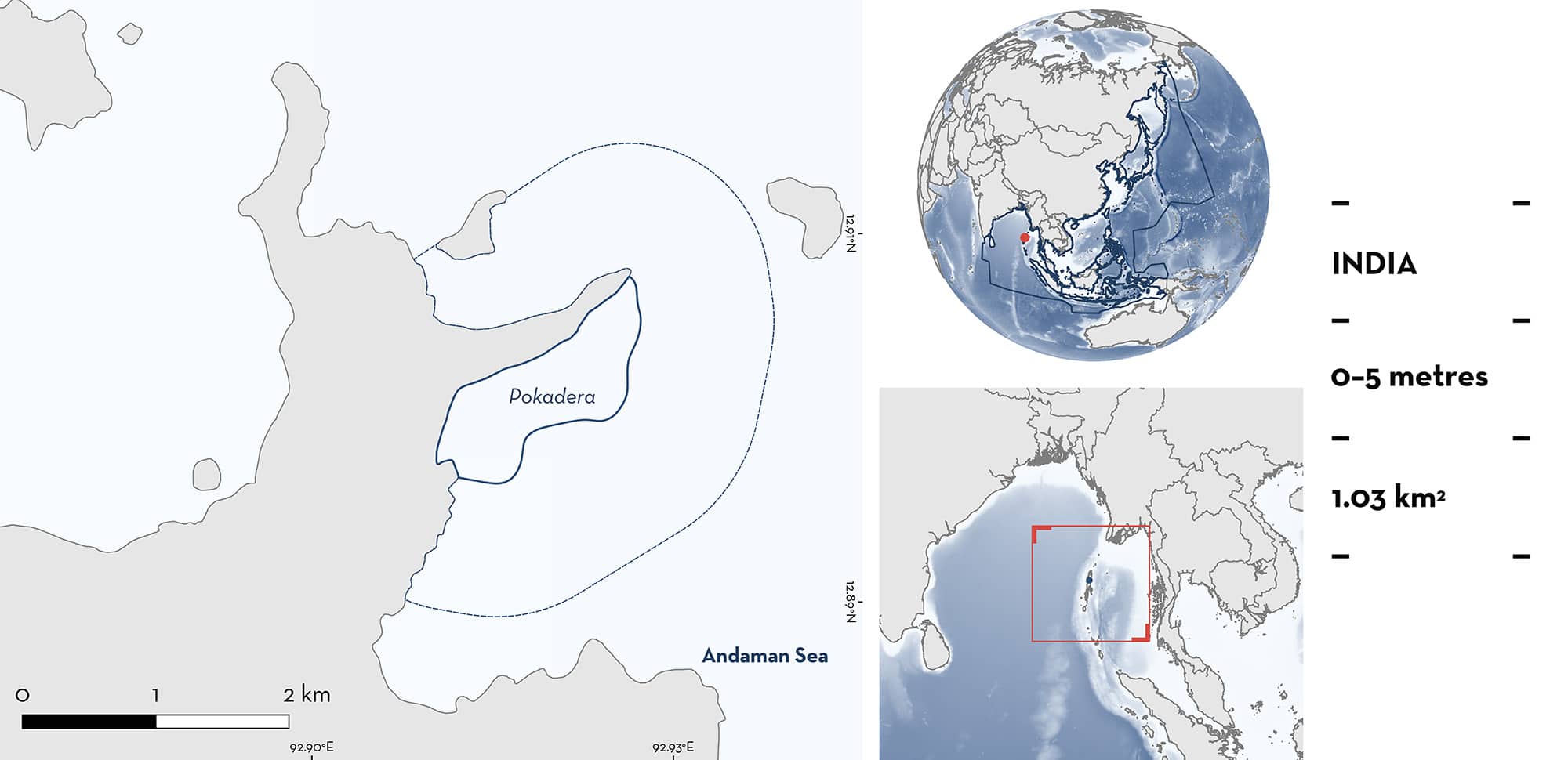ISRA FACTSHEETS
ISRA FACTSHEETS
ASIA REGION
Pokadera
Summary
Pokadera is a shallow coastal area on the east coast of Middle Andaman Island in the Andaman and Nicobar Islands, India. The area has a gentle slope, providing shallow, primarily sandy, habitat sheltered within a bay. Pokadera also contains dense seagrass meadows. Within the area there are: threatened species and reproductive areas (Giant Guitarfish Glaucostegus typus).
Download factsheet
Pokadera
DESCRIPTION OF HABITAT
Pokadera is situated on the east coast of Middle Andaman Island in the Andaman and Nicobar Islands of India. This archipelago is located ~1,360 km east of mainland India, situated between the Bay of Bengal and the Andaman Sea (Nazareth et al. 2022). It is part of an undersea mountain range that extends from the west coast of Myanmar to the northwest coast of Indonesia. The Andaman Islands comprise over 325 islands, of which 21 are inhabited (Census of India 2011).
These oceanic islands have a limited continental shelf covering ~16,000 km2, and almost no continental slope. They are also part of the Indo-Myanmar and Sundaland biodiversity hotspot (Roberts et al. 2002). They are not only diverse in the biodiversity they support, but also the types of ecosystems and habitats that exist along the coast, with mangroves, coral reefs, seagrass meadows, algal beds, and habitats like creeks, inlets, bays, estuaries, and lagoons. This diversity has led to the islands being highly productive (Ramachandran 2000).
Pokadera is a shallow coastal site with a gentle slope, providing shallow, primarily sandy, habitat sheltered within a bay. This site also contains dense seagrass meadows (Rao et al. 2023).
The Andaman and Nicobar Islands receive seven months of rain a year due to the southwest and northeast monsoons which together last from May to December (Patankar 2019).
This Important Shark and Ray Area is benthic and is delineated from inshore and surface waters (0 m) to 5 m based on the depth range of Qualifying Species in the area.
CRITERION A
VULNERABILITY
One Qualifying Species within the area is considered threatened with extinction according to the IUCN Red List of Threatened Species. The Giant Guitarfish is assessed as Critically Endangered (Kyne et al. 2019).
CRITERION C
SUB-CRITERION C1 – REPRODUCTIVE AREAS
Pokadera is an important reproductive area for one ray species.
Local ecological knowledge (LEK) collected between September 2019 and June 2020 from coastal stakeholders (including fishers, coastal residents, dive operators, forest department staff) of the Andaman Islands revealed that early life-stage Giant Guitarfish are utilising the shallow coastal waters of the area (Nazareth et al. 2022). Three of the five respondents that had reported observing Giant Guitarfish at Pokadera said that they had observed them daily.
In addition to the LEK, Visual Transect Surveys (VST) and Baited Remote Underwater Video Station (BRUVS) surveys were conducted at this site between 2021 and 2023 (E Nazareth unpubl. data 2021–2023). This included 24 VTS with 65 Giant Guitarfish detections and 38 BRUVS with 8 detections between April and July 2021, 7 VTS with 13 detections in January 2022, and two VTS with 8 detections in April/May 2023. In addition to these surveys, periodic visits to the area during other field programs recorded juvenile Giant Guitarfish at all times of the year across multiple years (2021–2024) (E Nazareth et al. unpubl. data 2024). The individuals observed were estimated to be 30–45 cm total length (TL) (except for one individual detected on BRUVS that was estimated to be ~100 cm TL) and were classified as neonates and young-of-the-year based on sizes-at-birth reported in the literature (35–40 cm TL; Last et al. 2016; Freeman 2019; Gaskins et al. 2020). Pokadera provides shallow inshore habitat consistent with habitat reported for early life-stage Giant Guitarfish elsewhere (e.g., Freeman 2019; Gaskins et al. 2020).
Download factsheet
SUBMIT A REQUEST
ISRA SPATIAL LAYER REQUEST
To make a request to download the ISRA Layer in either a GIS compatible Shapefile (.shp) or Google Earth compatible Keyhole Markup Language Zipped file (.kmz) please complete the following form. We will review your request and send the download details to you. We will endeavor to send you the requested files as soon as we can. However, please note that this is not an automated process, and before requests are responded to, they undergo internal review and authorization. As such, requests normally take 5–10 working days to process.
Should you have questions about the data or process, please do not hesitate to contact us.


